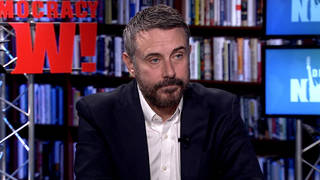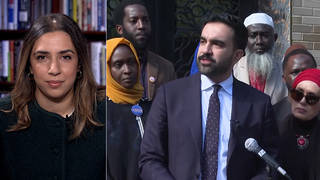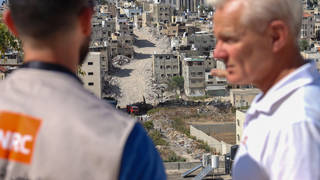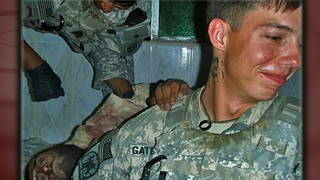
Guests
- Neil Sheahas reported on the wars in Afghanistan and Iraq since 2006 for Stars and Stripes and The Christian Science Monitor, among other publications. His latest article in The American Scholar is called “Afghanistan: A Gathering Menace: Traveling with U.S. Troops Gives Insights into the Recent Massacre.”
We speak with journalist Neil Shea, who has reported on Afghanistan and Iraq since 2006 for Stars and Stripes and other publications. Shea discusses his experiences witnessing disturbing behavior during his travels with U.S. troops in Afghanistan and offers insight into understanding the massacre of 16 Afghan civilians. “When we cycle our soldiers and marines through these wars that don’t really have a clear purpose over years and years…we expect light-switch control over their aggression,” Shea says. “We expect to be able to turn them into killers and then turn them back into winners of hearts and minds. And when you do that to a man or a woman over many years, that light-switch control begins to fray.” [includes rush transcript]
Transcript
JUAN GONZALEZ: Afghan President Hamid Karzai is set to meet today with the families of 16 civilians killed in a massacre allegedly committed by a single U.S. soldier. Yesterday Karzai called on U.S. troops to withdraw from Afghan villages. Meanwhile, the Taliban has announced they’re suspending peace talks, even as U.S. officials say they hope to stick around to a 2014 withdrawal schedule for troops in Afghanistan.
After meeting with Karzai, U.S. Defense Secretary Leon Panetta again promised the unnamed suspect in the shooting rampage that killed mostly women and children would be brought to justice
DEFENSE SECRETARY LEON PANETTA: I assured him that, first and foremost, that I shared his regrets about what took place, that we extended our deepest condolences to the families, to the villages and to the Afghan people over what occurred. And I again pledged to him that we are—we are proceeding with a full investigation here, and that we will bring the individual involved to justice. And he accepted that.
JUAN GONZALEZ: That was Defense Secretary Panetta.
Many Afghans have raised questions about the U.S. military’s statements on the massacre. On Thursday, the Pajhwok Afghan News agency reported an Afghan parliamentary probe determined up to 20 U.S. troops were involved in the massacre. The Afghan lawmaker Hamizai Lali told the agency, quote, “We are convinced that one soldier cannot kill so many people in two villages within one hour at the same time, and the 16 civilians, most of them children and women, have been killed by the two groups.”
AMY GOODMAN: The U.S. soldier accused in the massacre has been flown out of Afghanistan to a detention center in Kuwait despite several Afghan lawmakers and residents saying he should have been tried in Afghanistan. A senior U.S. commander defended the move, saying it was made to help ensure a proper investigation and trial. The suspected killer’s name has not been released, but he has been identified as a 38-year-old staff sergeant who served three tours of duty in Iraq, where he suffered a head injury. This was his fourth tour of duty, in Afghanistan.
Yesterday, prominent Seattle defense attorney John Henry Browne announced he will represent the soldier. Browne’s past clients include serial burglar Colton Harris-Moore and serial killer Ted Bundy. At a news conference in Seattle, Browne said the soldier’s family was shocked at what happened.
JOHN HENRY BROWNE: He was told that he was not going to be redeployed. And they were—the family was counting on him not being redeployed. And so, he and the family were told that his tours in the Middle East were over. And then, literally overnight, that changed. So I think that it would be fair to say that he and the family were not happy that he was going back…
Oh, they were totally shocked. He’s never said anything antagonistic about Muslims. He’s never said anything antagonistic about Middle Eastern individuals. He’s, in general, been very mild-mannered. So, they were very shocked by this.
AMY GOODMAN: We’re joined now by journalist Neil Shea. He’s joining us from Raleigh, North Carolina, has reported on Afghanistan for many years for Stars and Stripes, the military newspaper, and The Christian Science Monitor, among others. His latest article in The American Scholar is called “Afghanistan: A Gathering Menace: Traveling with U.S. Troops Gives Insights into the Recent Massacre.”
We welcome you, Neil, to Democracy Now! Yours is an extremely disturbing article. Tell us what you have found. Just walk us through the descriptions you share in your piece.
NEIL SHEA: Well, good morning, Amy and Juan.
I found that during one of my last trips to Afghanistan, I met up with a group of soldiers who were the first I had ever come across who made me feel pretty nervous about what I was going to see while I was with them. And I spent a few days with them and came to just really understand that they had gotten to the edge of violence, as we understand it, in Afghanistan, and they seemed ready and capable of doing some pretty bad things. I didn’t actually witness them do anything too terrible, but the way that they talked and the way that they acted toward Afghan civilians and animals and property in the country was sort of stunning to me. And that’s what I describe in the article. It’s talking about these—this group of soldiers and sort of their mental state during a multi-day mission in a central part of Afghanistan that was supposed to be a Taliban stronghold. Many of these guys seemed like they had reached the end of their rope in terms of stability and controlling their aggression.
JUAN GONZALEZ: Well, Neil, what I found amazing about your story is, as you say, you focus not on any high-profile event that might be considered something illegal done by the troops or a war crime, but on the everyday occurrences that created greater and greater distance between this particular group of U.S. soldiers and the civilian population. At one point, you write, “Evil or atrocity often explodes from a furnace built by the steady accretion of small, unchallenged wrongs. Some men in Destroyer platoon had been drifting that way for a long time.” Can you talk about some of those incidents that you witnessed that were part of this buildup of the psychological perspective, viewpoint of these men?
NEIL SHEA: Sure, Juan. In some ways, this article was a culmination of things that I’ve seen since 2006, when I first started covering the wars in Iraq and Afghanistan. And during those years, I’ve seen soldiers and marines sort of build up through these cycles of aggression, to the point where they start doing—they begin with small things. They’ll insult Iraqis or Afghans behind their backs, and that’s sort of the very mild beginning of it. And then they sort of move up the chain, if we can call it that, into more serious acts of aggression, where they’ll kill animals or they’ll beat somebody or treat them roughly, and it sort of builds up from there.
What I saw with these guys in Afghanistan when I was with them was that several of them had already been through multiple tours in Iraq and Afghanistan, and they had reached a point where they hated Afghans, they hated the country, and they were really not interested in doing any of the hearts and minds stuff anymore that’s a crucial part of the mission. So by the time I reached these guys, they had already been sort of—they had been building up anger and aggression in strange ways for a number of years. And when I saw them, they had just shot a dog that had been a pet in an Afghan home that they had confiscated during the mission, and they treated Afghan civilians fairly roughly, and they took a few prisoners and treated them very roughly, as well. Nothing that would rise to necessarily the—sort of a crime at that time, but the way that they talked about things and the way that they sort of handled themselves was really aggressive. And it was only—it seemed to me only to be barely kept in check.
So it’s just this small—when we cycle our soldiers and marines through these wars that don’t really have a clear purpose over years and years, I write in the article that we begin—we expect light-switch control over their aggression. We expect to be able to turn them into killers and then turn them back into winners of hearts and minds. And when you do that to a man or a woman over many years, that light-switch control begins to fray. And that’s what I believe I was seeing with these guys in Afghanistan.
JUAN GONZALEZ: You also mention something that I don’t think many Americans here realize, that when these platoons go out, especially on multi-day patrols, that they often just take over the homes of Afghans, evict them, and give them a few dollars and basically order them out of their homes and take them over for their own—for their own refuge. And this creates—you quote one soldier saying, “Well, we helped create more Taliban today,” because of—the soldiers themselves recognizing that their actions were creating enormous hostility in the population.
NEIL SHEA: Right. This is—this was a fairly standard practice in Afghanistan, and even in Iraq. When platoons were moving out through really rural areas or even some urban areas, they needed a place to bed down for the night. They’d try to find either an abandoned house or, if they couldn’t find an abandoned one, they would move into a place that was relatively secure, and they’d sort of kick the family out and try to pay them for their trouble. In this particular case, I was told that the Afghans didn’t take the money from the American troops, because they didn’t want anyone in the region to think that they were siding with the Americans. They were afraid that by taking the money, they’d be seen as American sort of collaborators and perhaps killed later.
But the point I was trying to make when I talked about—when I quoted that soldier as saying that they were on a Taliban recruiting drive, he was actually talking about the fact that they had—they had treated the Afghans so badly during the mission that the Afghans were going to obviously choose the side of the Taliban, because now they hated the Afghan army and they hated the Americans. So the brutal treatment that the Americans had sort of pushed upon them drove these civilians into the arms of the Taliban. And that’s what that particular soldier was talking about. And American soldiers all across Afghanistan run into that problem, just as they did in Iraq, where they have a job to do, but sometimes they have to do it so roughly that the civilian population actually turns against them. And so, that’s what that was about.
AMY GOODMAN: Neil Shea, you quote an American Army sergeant, who said to you, “This is where I come to do f*****-up things.” And I wanted to ask you about this report we can’t confirm that says “Up to 20 U.S. Troops Executed Panjwai Massacre: Probe” by Bashir Ahmad Naadimon. And it’s from Kandahar city (PAN). It says, “A parliamentary probe team on Thursday said up to 20 American troops were involved in Sunday’s killing of 16 civilians in southern Kandahar province.” Now, all the information that we are getting about what took place is from the military—you know, who this man is; the number of tours of duty—he had three in Iraq, one in Afghanistan; that he had a TBI, a traumatic brain injury, in a rollover in Iraq; and now he’s been taken out, so we don’t have any access to him. So that’s what the U.S. is saying. And the New York Times spoke to family members of some of the people who were killed, so we know what happened to some of the people killed. But what about this kind of story that is going around in Afghanistan? Do you find it credible, the idea that it was more than one person who did the killing?
NEIL SHEA: At this point, I don’t really think that it’s credible. While it still is possible that it was more than just this one soldier who were involved in it, I think that the idea that it was 20 soldiers from one particular unit going into a village to just sort of slaughter people, that actually sounds very far off base to me. And I do know that in Afghan culture, at least from my observations, rumors travel very quickly, and they take on their sort of—they gather facts as they go, in sort of like a game of telephone. So, I wouldn’t be surprised if this story was sort of exaggerated and built up by this point. It would really shock me if it was an organized effort by a group of 20 U.S. soldiers, because—well, for the simple reasons that it would be difficult for—to keep a heinous crime like that so quiet. Even though the U.S. military is sometimes good at keeping things quiet, that would be almost too big for them to squash.
JUAN GONZALEZ: And Neil, I’d like to ask you—you’ve been reporting, as you say, from Iraq and Afghanistan now for several years—the length of this war in Afghanistan, more than 10 years now, what it’s done to the American military?
NEIL SHEA: Well, I was asking—when I was there last time, I was actually asking specific soldiers about this, what they thought the military—what damage had been done to the military during the war. And many of them felt that the military had actually been broken by this continued cycle of war. These were usually staff sergeants, command sergeants, mid-level sergeants who are sort of the backbone, as they call them, of the Army. And they really felt that the—a lot of things had deteriorated and eroded during the last 10 years. And soldiers and marines, even airmen in the other branches, told me this. So I think that there’s been a great degree of strain on the American military, particularly in Afghanistan. And that’s partly because, since the beginning of the war, the goal has changed, and the mission has changed, so every few years the military is having to adapt to something new. And there doesn’t really seem to be a clear exit strategy. And so, just sort of constantly refitting itself to adapt to a changing set of demands has created incredible strain.
AMY GOODMAN: And finally, the—you know, how we know what we know right now about what’s happened. Of course, there was the story of Pat Tillman, the belief—originally, the U.S. military put out that he was killed by enemy fire, and ultimately, of course, it was, if you call it, “friendly fire.” It was fellow soldiers. And then taking that to this story.
NEIL SHEA: So I guess you’re asking about whether or not it could be sort of a cover-up, or the nature of information?
AMY GOODMAN: Right, not trying to figure out how we know what we know, as the people in the United States and Afghanistan deal with what took place.
NEIL SHEA: Right.
AMY GOODMAN: We have to be very aware of what our source of information is, that we don’t have independent confirmation.
NEIL SHEA: Yeah, indeed. I think that it’s entirely possible that right now we’re just sort of being led along with the thinnest of facts. So I’m reluctant to talk about this too much. But, you know, the U.S. military does have a history of trying to keep things under wraps, and particularly something like this. I know the temptation is very strong for them to sort of try to control the story and the message very tightly. So it will be very difficult for journalists to get into this story and sort of crack it open, but absolutely necessary for us to understand not only what happened in Kandahar, but what’s happening to the men and women that we ask to go fight this war.
AMY GOODMAN: Neil, we want to thank you very much for being with us. Neil Shea has reported in Afghanistan for many years for Stars and Stripes, The Christian Science Monitor, among others. His latest article is in The American Scholar; it’s called “Afghanistan: A Gathering Menace: Traveling with U.S. Troops Gives Insights into the Recent Massacre.” We will link to it at our website, democracynow.org. Neil is speaking to us from Raleigh, North Carolina.












Media Options